Updated October 2018; Originally posted May 2016
Luke Milliron, UCCE Orchard Systems Farm Advisor, Butte, Tehama, and Glenn Counties; Franz Niederholzer, UCCE Farm Advisor in Colusa and Sutter/Yuba Counties; Themis Michailides, UC Davis Plant Pathologist
Cytospora is a major pest of prune trees, killing bearing wood, reducing yield potential and even killing trees. It is a fungal canker, meaning a fungal disease of the bark (see figure 1). This canker disease is perennial, so once the fungus has successfully infected the bark, it can continue to grow every year, resulting in branch girdling and even tree death. This disease is widespread in prune orchards in California. It is present, to some degree, in every mature prune orchard the authors have ever visited. To minimize damage from this disease, several important steps must be taken.
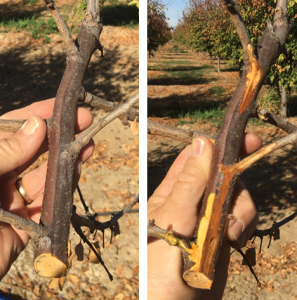
Figure 1. A clearly delineated Cytospora canker (brown dead bark; pruning wound infection) in young prune orchard with widespread infection (fall 2018, photo by Franz Niederholzer).
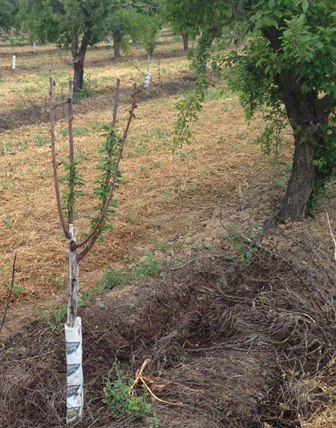
Figure 2. Second leaf interplants in a mature orchard with Cytospora infections likely caused by pruning wounds. Cytospora pycnidia (spore source) are present in the mature trees.
These cankers first girdle branches causing branch dieback. If not pruned out properly, cankers continue to grow down into primary scaffolds killing more wood as they expand. Major scaffold limbs will die (figure 3) with trees compromised sufficiently to require tree removal if these cankers are not eliminated early enough through proper pruning.
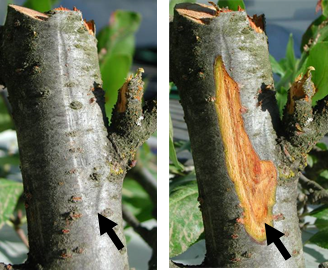
Figure 3. The lower margin of a Cytospora canker is detected as a sunken area on the branch where bark has been killed. Arrows point to canker edges, revealed by a knife cut in the second photo.
To identify limbs killed or weakened by cytospora cankers, look for dark, sunken cankers on the bark of limbs showing dieback, or branches where dead leaves are still attached. Active cankers have distinct zonate margins (figure 3). Small white spots called pycnidia found on dead wood confirm the presence of Cytospora (figure 4).
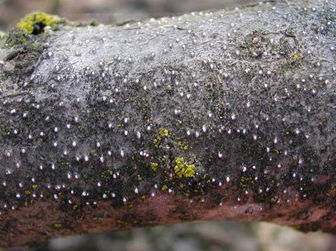
Figure 3. Pycnidia, characteristic of Cytospora, are black or white pimple-like spore producing structures found on dead wood.
During the post-harvest period, two key management practices in orchards with Cytospora are to avoid tree water stress by carefully managing irrigation and pruning out existing cankers. Cutting out existing cankers should be performed during the growing season when enough leaves are still present to easily identify these girdled branches. Leaves on these branches are likely either in decline or dead and remain frozen in place. These branches with sunken cankers should be cut several inches, to one foot below any cankered bark (check for darkened edges, see figure 2). If the canker is not completely removed, the disease is still in the tree, and money is wasted. To reduce disease inoculum, remove and destroy cankered wood that is pruned out, as well as trees killed by Cytospora.
Pruners should be trained to spot Cytospora canker and to cut below the symptoms. In our experience, pruning crews are often loath to make the extensive cuts required to remove Cytospora cankers. Therefore, growers, managers and/or PCAs should monitor pruning cuts or downed wood to make sure pruners are making clean cuts – not leaving Cytospora in the trees – as they move across the block.
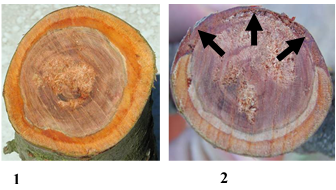
Figure 4. Good cut (1) made below canker margin showing only clean bark. Cut several inches to 1-foot past cankered regions. Bad cut (2) not far enough down the limb showing diseased bark (arrows) and canker still remaining in the tree.
Cutting out cytospora in vigorous orchards must be balanced with orchard performance and how much bearing surface is left after all damaged scaffolds and branches are cut out. All older orchards show some cytospora. Well-managed orchards – adequate water, nitrogen, potassium, etc. – will not be as impacted by cytospora as weaker blocks.
In order to maintain production in strong orchards, a grower may elect to leave some limbs with bark damage in the tree, even if sunburned or cytospora infected. If production is off and the orchard is filled with cytospora cankers, but strong water sprouts are found in the crotches and lower branches, remove larger older wood with cankers and improve irrigation and fertility. For a weak orchard riddled with cytospora and wood rot, the best approach might be replanting. Bottom line: all growers should spend a day with a saw and this pocket guide to evaluate each orchard.
Protect fresh cuts!
Cytospora spores are carried in wind and/or rain and move to new infection sites (sunburned scaffolds, pruning wounds, etc.) in wet and windy weather. The post-harvest pruning period is a key opportunity for avoiding new infections. Whether making mechanical cuts or pruning with loppers, fresh cuts are susceptible infection entry points for rain-splashed fungal spores from Cytospora as well as other fungal diseases like Botryosphaeria. Work by the lab of Dr. Themis Michailides, UC Plant Pathologist, has shown that fresh pruning cuts remain susceptible to rain-splashed fungal infections for at least 30 days.
Spraying with protectant fungicides such as Topsin®-M, or Topsin®-M and Rally® WP after pruning and before any rainfall can reduce canker infection. These two fungicides now have a 2EE label for treating pruning wounds in prunes, as well as almonds, other stone fruits and grapes. While the efficacy of Rally® WP alone hasn’t been evaluated by UC researchers, when paired with Topsin®-M it does offer a different FRAC group for improving resistance management. Always carefully read and follow the pesticide label. Cutting out diseased wood and protecting pruning wounds with fungicide(s) will help reduce the level of Cytospora canker in prune orchards, thus improving yield and future orchard income.


Leave a Reply